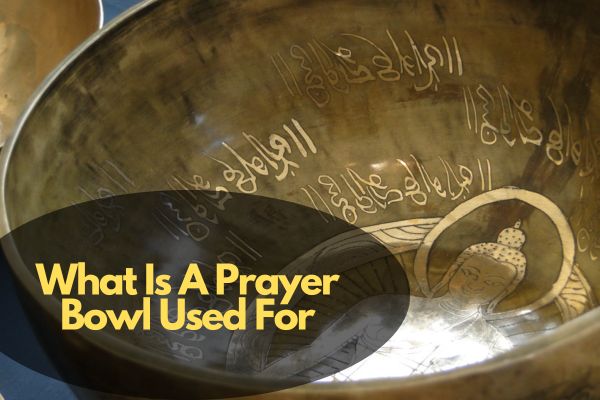Table of Contents Show
In the realm of spirituality and mindfulness, prayer bowls hold a special place. These enigmatic instruments have been used for centuries in various cultures to create a calming and meditative atmosphere. But what is a prayer bowl used for, and why are they so revered? This article aims to shed light on the many facets of prayer bowls, their uses, and the profound impact they have on our inner peace and well-being.
What Is A Prayer Bowl Used For
Prayer bowls, also known as singing bowls, have a rich history and serve a unique purpose in various cultures and spiritual practices. These beautiful, resonant instruments have become a symbol of mindfulness, meditation, and inner peace. It used for these purposes:
Prayer and Meditation: The primary purpose of a prayer bowl is to aid in prayer and meditation. When gently struck or rubbed, these bowls produce soothing, harmonic sounds that have a remarkable ability to transport individuals into a state of deep meditation. The resonating tones help clear the mind and create a tranquil atmosphere for introspection and prayer.
Balancing Energy: Prayer bowls are believed to have the power to balance the body’s energy centers, often referred to as chakras. The vibrations generated by these bowls help remove blockages, promoting physical and emotional healing. The harmonious sounds emitted during use can help restore harmony and balance in one’s life.
Stress Reduction: In today’s fast-paced world, stress has become a common adversary. A prayer bowl’s soothing sounds can alleviate stress and anxiety, promoting a sense of calm and relaxation. These bowls are often used in therapeutic settings to reduce tension and create a serene environment.
Spiritual Connection: Many individuals use prayer bowls as a tool to enhance their spiritual practices. The resonant tones are thought to connect with higher realms and facilitate a deeper spiritual connection. This connection can help one gain insights, receive guidance, or simply experience a sense of oneness with the universe.
The History of Prayer Bowls
Origin and Evolution: Prayer bowls have deep roots, with origins in Asia, particularly in countries like Tibet, Nepal, and Bhutan. These bowls date back centuries, and their use has evolved over time.
Cultural Significance: Different cultures have embraced prayer bowls, each infusing its unique spiritual significance. In Tibetan Buddhism, for example, they are called “Tibetan singing bowls” and are an essential part of meditation and prayer.
Symbolism: Prayer bowls often carry symbolic designs, with intricate engravings and various shapes. These symbols can vary from culture to culture and can represent aspects of spirituality and mindfulness.
Crafting a Prayer Bowl
Materials: Traditional prayer bowls are crafted from a combination of metals, typically seven. These metals include copper, tin, iron, silver, gold, mercury, and lead. The specific combination of metals and the proportions used affect the sound produced by the bowl.
Craftsmanship: Crafting a prayer bowl is a skilled art form. Artisans carefully shape and engrave the bowl to create a resonance that produces a unique and soothing sound when struck or played.
Design and Symbols: The design of a prayer bowl is significant. Some bowls feature intricate patterns, while others may incorporate religious symbols or mantras.
How to Use a Prayer Bowl
Choosing the Right Location: To make the most of your prayer bowl, select a quiet, peaceful location free from distractions. This sets the stage for a more focused and enriching experience.
Preparing Yourself: Before you begin, take a moment to center yourself. Close your eyes, take a few deep breaths, and set your intention for the session. This prepares your mind for a more meaningful experience.
Striking the Bowl: To create sound, the bowl is often gently struck with a mallet. The bowl is typically placed on a soft surface to allow it to vibrate freely.
Circling the Rim: Another technique involves circling the rim of the bowl with the mallet, creating a sustained, resonating sound.
Breathing and Meditation: Prayer bowls are often used in meditation. Practitioners focus on the sound and vibration, allowing it to guide their breath and concentration.
Spiritual Significance
Various Religions: Prayer bowls are not limited to a single religion. They are used in a range of spiritual practices, including Buddhism, Hinduism, and even in some Christian traditions.
Connection to the Divine: In many belief systems, prayer bowls are seen as a means of connecting with the divine or achieving a heightened state of consciousness.
Rituals and Ceremonies: Prayer bowls are often featured in rituals and ceremonies, symbolizing a link between the physical and spiritual worlds.
Cultural Variations
Tibetan Singing Bowls: In Tibet, prayer bowls are an integral part of religious and spiritual practices. They are often used in monasteries and temples.
Nepali Prayer Bowls: In Nepal, prayer bowls are crafted with distinct designs and patterns, reflecting the rich culture and artistry of the region.
Bhutanese Influence: Bhutan, a country known for its unique culture and spirituality, also has its variations of prayer bowls.
Collecting and Owning a Prayer Bowl
The Art of Collecting: Many individuals are drawn to collecting prayer bowls. It’s an art and a passion, with collectors valuing the uniqueness and resonance of each bowl.
Finding Authentic Pieces: Authenticity is crucial when collecting prayer bowls. Experts can help identify genuine antique bowls and their origins.
Caring for Your Bowl: Proper maintenance is essential to keep your prayer bowl in good condition. Regular cleaning and handling are key aspects of bowl care.
Modern Uses of Prayer Bowls
Beyond Meditation: In the modern world, prayer bowls have expanded beyond meditation. They are used in various relaxation and wellness practices.
Sound Baths: Sound baths, which incorporate prayer bowls, have gained popularity for their therapeutic effects on mental and emotional well-being.
Everyday Use: Some people use prayer bowls as part of their daily routines, incorporating them into their rituals for clarity and peace.
Benefits of Using a Prayer Bowl
Stress Reduction: The soothing sound and vibrations created by prayer bowls can reduce stress and promote relaxation.
Enhanced Focus: The sound of the bowl helps practitioners focus their minds during meditation and mindfulness exercises.
Sound Therapy: The therapeutic benefits of sound therapy, including prayer bowl use, are increasingly recognized and employed in wellness practices.
Choosing the Right Prayer Bowl
Considerations: When selecting a prayer bowl, various factors should be taken into account, including the size, design, and intended use.
Finding Resonance: Many individuals believe that a prayer bowl should resonate with them personally, creating a connection that enhances its effectiveness.
Resources: Finding the right prayer bowl often involves visiting reputable sellers and exploring online resources dedicated to these instruments.
Stories and Testimonials
Transformational Experiences: Many individuals share stories of how prayer bowls have transformed their lives, bringing them peace and healing.
Testimonials: Personal testimonials from meditation practitioners and individuals who have incorporated prayer bowls into their lives.
The Power of Sound: Stories of the profound impact of sound therapy and how prayer bowls have played a role in enhancing well-being.
Conclusion
In conclusion, prayer bowls have a rich history and serve various purposes in today’s world. Whether used for meditation, relaxation, or therapy, these beautiful instruments continue to have a profound impact on the well-being of individuals. Their resonance, both in sound and spiritual significance, makes them a unique and cherished tool for many. Whether you’re drawn to the cultural history or the therapeutic benefits, prayer bowls offer a connection to the divine and a path to inner peace.
FAQs
1. Are prayer bowls only used for meditation?
- While meditation is a common use, prayer bowls have various purposes, including sound therapy and stress reduction.
2. Can anyone use a prayer bowl, or is it limited to certain belief systems?
- Anyone can use a prayer bowl, and they are not limited to specific belief systems. They have a universal appeal.
3. Are there different types of prayer bowls for specific purposes?
- Yes, there are different types of prayer bowls designed for various purposes, including meditation, healing, and relaxation.







